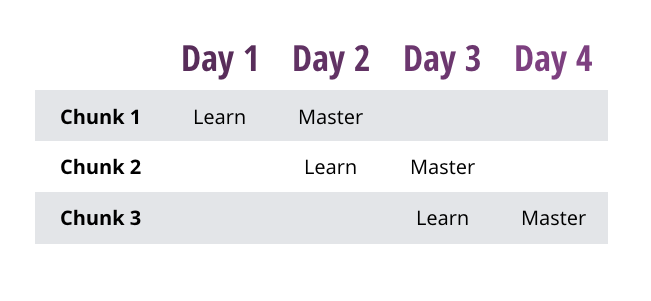Practice Strategy: Chunking
Chunking is, in my opinion, one of the best strategies to learn pieces. Not all parts of a new piece are the same difficulty and so those parts need more work than others for you to play it all at the same fluency.
Chunking consists of identifying the more difficult parts of a piece (the chunks) and then mastering them as isolated parts. Usually, you are breaking up a piece into very fine sections (it could be as small as two beats or a measure!). Then, you practice these parts separately so that you master it and bring it up to the same level as the easier sections. This way, when you run through a piece, you won’t get stuck or falter at these more difficult sections.
1. Find the chunks
Work with your teacher to pick out difficult parts: usually, they will know the common ‘problem areas’ that most students struggle with. Or, do a quick read through the piece, and find out where you stop or get stuck. Maybe there’s big octave jumps in a measure, or a fast line with some tricky fingering that you need to work out beforehand. Circle those parts immediately. When you’ve gone through the whole piece, you’re left with your ‘chunks’ marked to work out separately!
2. Pace yourself
Don't expect to get it in one session! There's a reason why you're chunking a section: it's difficult. Sometimes you have to sleep on it, and you will be a lot closer when you start again the next day. For example, you can focus on learning a chunk one day and then mastering it the next. Here's what a possible plan for that could look like:

3. Start slow
Just because you have a chunk that’s only 2 beats long doesn’t mean you can speed through it a tempo and hope your fingers catch it. Start slow so you aren’t practicing errors. Make sure your fingerings are right. If there are easier ways to get to certain notes, mark that so you remember to practice with it every time. Play it so slow that you cannot mess up, then gradually increase the speed from there. Occasionally, you can jump up the tempo and see if you can play it. If not, go back! If you’re trying to practice fast but are messing up 3 out of 4 times, you’re wasting your time. Try the 2 Up 2 Down game. This is a fun way to master difficult sections and get to the required tempo quickly.
4. Incorporating it into the rest of the piece
You’ll need to be able to attach that mastered chunk in with the rest of the piece. I see many students who haven't done this last step get to the chunk and briefly pause before playing it. To be able to seamlessly transition from practicing a chunk to practicing the whole phrase including the chunk, you’ll have to use another strategy called chaining. Basically, you make the chunk a little bigger, master that, then a little bigger again, then master that, etc. until you have brought it out of isolation.
 Better Practice Blog
Better Practice Blog